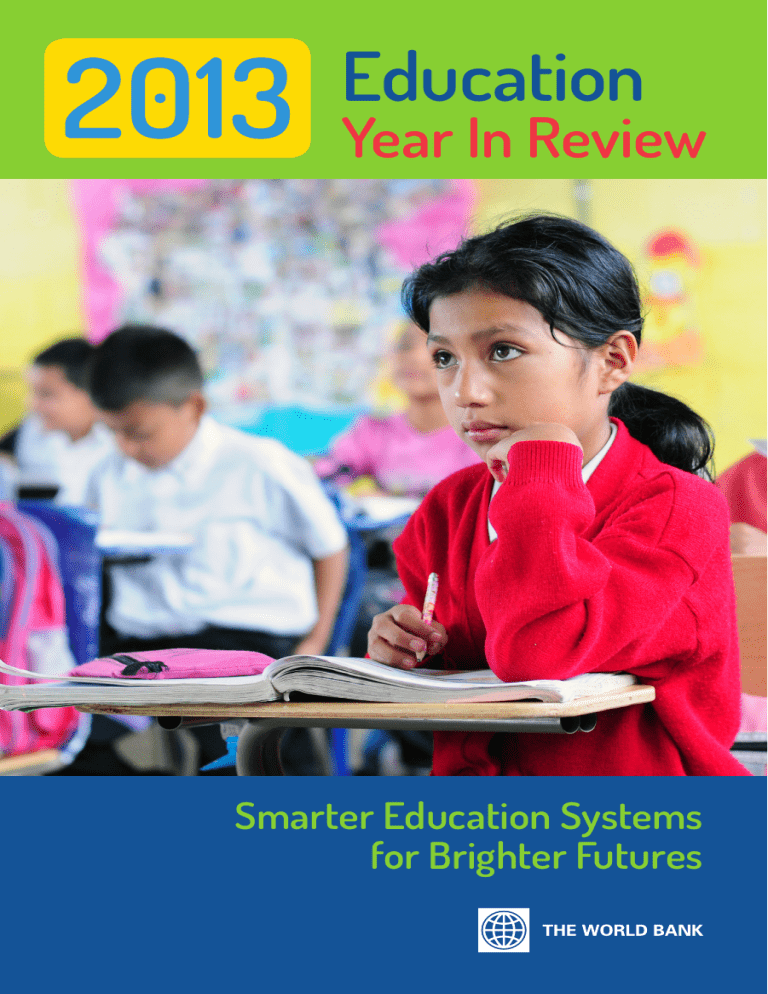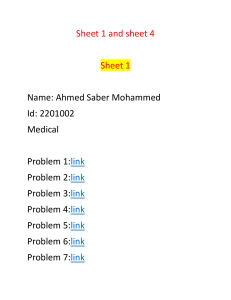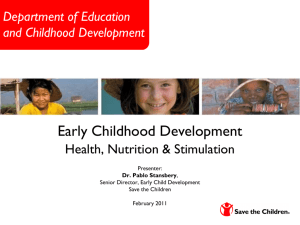
Education Year In Review Smarter Education Systems for Brighter Futures Education and the World Bank E ducation is one of the most important drivers for ending poverty and boosting shared prosperity, the two pillars of the World Bank Group’s strategy. Guaranteeing the human right to a basic education means little unless schooling leads to learning for all children and youth. Growth, development, and poverty reduction depend on the knowledge and skills that young people acquire—not just the number of years they sit in a classroom. But learning levels remain alarmingly low. In low-income countries, many young people complete basic education without acquiring fundamental literacy and numeracy skills. Even in middle-income countries, many students do not acquire the basic skills that are expected by employers and needed to secure a job. Today, an estimated 250 million children around the world are unable to read and write, even after spending three or more years in school. The urgency of improving the quality of education and accelerating learning globally has never been greater. The Bank recognizes the need to ensure that the 57 million children out of school today not only attend school, but also receive a quality education that will prepare them to conquer the challenges facing the 21st century. Learning for All, the World Bank Group’s education strategy, responds to this growing challenge. In support of this strategy, the Bank is working towards expanding educational opportunities for children, youth, and nations alike by providing policy advice, technical support, and knowledge of what works in education, as well as financing totaling $2.9 billion in fiscal year (FY) 2013, up sharply from $1.8 billion in 2011. In September 2012, World Bank Group President Jim Yong Kim reaffirmed the Bank’s 2010 Millennium Development Goals (MDGs) Summit pledge to commit an additional $750 million in financing for basic education over five years (2011–2015) from the International Development Association (IDA) to help the poorest countries accelerate progress toward the 2015 MDGs for education. The total amount of new IDA commitments for basic education in FY13 was $1,260 million. This amount implies cumulative progress of $939 million towards our MDG pledge, exceeding that pledge by $189 million or 25 percent two years before 2015. 57 million 19% Tertiary Education 17% Upper Secondary/ Vocational 64% Basic Education 1–9 Grade (Includes Lower Secondary) WORLD BANK EDUCATION SUPPORT BY SUB-SECTOR (% OF) LENDING FY03–FY13 Cover photo: Maria Fleischmann / World Bank Out-of-school children worldwide in 2011, down from 108 million in 1999. Why do Education Systems Matter? L earning for All calls for education system reform beyond simply providing inputs. An education system’s ability to transform resources efficiently into better learning outcomes depends not only on having enough classrooms, teachers, and textbooks, but also on having the policy environment, resources, and accountability mechanisms that can promote—and not obstruct—education results. To this end, the Education Sector developed a tool, the Systems Approach for Better Education Results (SABER), which provides detailed system assessment of country capacities in a wide array of education Arne Hoel / World Bank policy areas. These include early childhood development (ECD), student assessment, teachers, school autonomy and accountability, and workforce development, among others. SABER’s aim is to improve education outcomes and efficiency by better informing policy makers, school management teams, teachers, parents, and students. The Bank’s SABER tools are being deployed in 104 countries and are informing investments in education at all levels. To date, 55 SABER country reports have been published. SABER IN ACTION 91% Global primary completion rate in 2011, up from 81% in 1999; Sub-Saharan Africa increased its rate from 53% to 69%. In Nigeria, 7 million children do not attend school. Net enrollment rates hover around 60 percent at the primary level and just 26 percent at the secondary level. To close these gaps, a Bank project designed using SABER analysis addresses four policy bottlenecks to achieve learning for all: 1. Teacher skills are not matched with student needs; 2. Standardized information on student learning and achievement levels is lacking; 3. The role of communities and school-based management committees in keeping schools accountable for results is weak; and 4. Data are not easily available to inform decisions made at different levels, from the school to the state level. Education Systems Defined S trengthening education systems is at the center of Learning for All. Rather than simply counting the number of schools built or children enrolled, the Bank focuses on the education system as a whole to make sure children can go to school and learn. The human body tells us a lot about the importance of a systems approach to education reform. Just as the human body cannot thrive without its component parts, from the skeletal and cardiovascular systems to the nervous and digestive systems, functioning together, education systems cannot thrive without the alignment and collaborative efforts of its policy areas. HUMA / World Bank An education system needs trained teachers who are innovative and effective, are paid adequately and on time, and receive performance evaluations; adequate resources that fund salaries and textbooks that reach the classroom and enhance teaching; learning assessments with results that inform policymakers, teachers, parents and students; an education management information system that monitors schools and forms the basis for the deployment of teachers and allocation of resources, and so on. These components make up the critical plumbing of the education system and it is only when they are connected that the education system can meet its challenges and achieve all its goals. Investing Early A child’s earliest years present the best window of opportunity to ensure good outcomes later in life. The potential returns to supporting early childhood development (ECD) during the first 1,000 days of life (from conception to 24 months) are substantial: improved cognitive development and capacity for lifelong learning, better health, and increased productivity in adulthood. The entry points to influence young children’s development within an education system are diverse and involve multiple stakeholders. They include investments in health care, hygiene, nutrition, and parental training to promote a child’s physical, cognitive, linguistic, and socio-emotional development. Programs can target the pregnant woman, the child, the caregiver, or the family as a whole and can take place in many environments, including the home, at a preschool or child care center, a health facility, or community center. Jump-starting learning through ECD The Bank is undertaking efforts to boost ECD in country programs and in the global development agenda. ECD is a component of the Bank’s education, health and nutrition, and social protection strategies. This year we financed eight new projects with an ECD component in Guinea, India, Jamaica, Nepal, Nicaragua, Peru, Uruguay, and Vietnam. Additionally, the Bank’s Education Staff Development Program launched a new learning course for staff and development partners, including an eLearning module. Generating new research The Bank is expanding the global knowledge base by bridging research, policy, and practice. To date, SABER tools are being used to assess ECD policies in 31 countries. The Liang Qiang / World Bank Strategic Impact Evaluation Fund (SIEF) program, which promotes impact evaluation research, training, and evidence-into-policy engagement on human development areas, is supporting the evaluation of nine promising ECD and nutrition programs. Boosting readiness for learning In Uganda, where only 14 percent of preschool age children attended preprimary school in 2010, a Bank project is supporting teacher training and policy reforms to enhance the enabling environment for ECD services for children aged 3–5 years. A project in Vietnam is helping to improve school readiness for 5-year-old children, with a special focus on those most at risk of being marginalized or falling behind their peers, by expanding full-day preschool enrollment. In Russia, the Bank is working to develop a more flexible regulatory policy environment to allow for the expansion of pre-primary education. Asia 6,000 50% South Gross enrollment rate for pre-primary education in 2011, more than double its rate in 1999. Indonesia ECD centers established since 2007, staffed by 12,000 trained teachers. Creating a Robust Learning Environment Improving learning for all is the Bank’s highest priority in education. A solid foundation of learning begins early and is vital for success in later years. For many children, their time in school has not led to expected learning levels, leaving them far short of the skills they need to thrive in today’s global markets. However, even well-designed policies and programs will not succeed in improving learning outcomes unless they are implemented and delivered effectively at the school and classroom levels. Measuring learning Assessing learning is critical for knowing who is learning, what is being learned, what influences learning, and how to improve it. As part of its ongoing engagement with the Learning DATA FOR RESULTS AND ACCOUNTABILITY The Service Delivery Indicators (SDI) initiative in Africa provides a set of metrics for assessing the delivery of primary education and basic health services. These measures can help governments and service providers identify performance gaps—especially among children and communities at risk due to fragility, conflict, or marginalization—and track progress within and across countries over time. SDI findings in Kenya, for example, are bringing to light that schoolchildren in public primary schools are taught for only 2 hours 40 minutes a day, not even half the official teaching day. 80% Ethiopia Net primary enrollment rate in 2012, compared to 61% in 2005. Metrics Task Force, the Bank recently brought together technical experts and policy researchers to discuss the existing student assessment tools and how to respond to the challenge of the post-2015 development agenda. In addition, the Bank has been working with countries to develop and strengthen national assessment programs. Focusing on the classroom A series of initiatives zero in on the classroom—where learning happens. A study in seven countries in Latin America and the Caribbean is assessing the quality of teacher training programs through classroom observation. So far, data have been collected in more than 14,000 classrooms in Brazil, Colombia, Dominican Republic, Honduras, Jamaica, Mexico, and Peru. Understanding what improves learning In Yemen, weak demand for education among lowincome families, especially for girls, is a hurdle. The Bank is addressing this through a conditional cash transfer program reaching more than 39,000 female students. A second phase of the project will extend it to an additional 25,000 students. Improving accountability Several projects addressed governance and accountability in 2013. Support to the Kyrgyz Republic is reforming basic education outcomes through a training program to improve teaching and strengthen the financial management of schools. A project in Pakistan is tackling secondary education by strengthening administrative systems and measuring student achievement. As part of this project, the Annual School Census will be administered through a third party with web-based direct reporting by schools. 790,000 Bangladesh The number of out-of-school children (more than half of them girls) who received “second chance” primary education between 2004 and 2012. Building Skills for a Productive Workforce Skilled workers are more likely to have jobs and earn higher incomes, and are better able to take advantage of economic opportunities. However, equipping the workforce with job-relevant skills is a continuing challenge around the world. The skills gap is especially evident in poorer countries and among disadvantaged groups. Despite rising educational attainment, many young people face prolonged unemployment or perform activities with very low productivity. Employers, for their part, find it difficult to fill vacancies and have noted scarcity of “soft skills,” which are essential for employment and productivity in today’s global economy. skills for professional and technical positions. These results should inform educational reform at all levels, from early childhood through tertiary education. To date, STEP surveys are underway in 13 countries. Supporting access to training Several projects addressed skills development in 2013. The Africa Higher Education Centers of Excellence Project is helping countries meet their labor market demands for skilled workers by strengthening 10 to 15 Centers of Excellence training and applied research in areas relevant to the region’s development. In Afghanistan, the Bank helped to establish the National Institute of Management and Administration, whose first cohort of graduates was able to find employment within six months of graduation. The project also provided short-term training in technical and business development for over 9,000 youth, more than a third of whom are women. Creating tools to measure skills The Bank’s new Skills Toward Employment and Productivity (STEP) Skills Measurement Survey is shedding light on skills gaps and mismatches by generating new, internationally comparable data on adult workers’ skills. STEP surveys collect data on cognitive and technical The STEP framework shows that skills needed for productivity and economic skills as well as behavgrowth require a combination of education, training, and labor market activities. ioral and social skills of adults in urban households and interviews Productivity employers about their & growth views on worker skills. In Vietnam, adult literacy is high (93 percent in 2011), but employers say that there are not enough skilled workers Getting children Ensuring that Building Encouraging Facilitating labor off to the right all students learn job-relevant entrepreneurship mobility and to fill available jobs. The start skills and innovation job matching survey finds that about Stepping Up Skills. ©2010. All rights reserved. The World Bank. 80 percent of job applicants lack the required 1 21% Mexico Share of poor students enrolled in tertiary education in 2011, compared to 6% in 2005. 2 3 190,000 4 5 Colombia Number of students who gained access to higher education between 2008 and 2013, 83% of whom belong to the most vulnerable sectors of the population. 2013 at a Glance Strengthening education systems through partnerships The Bank collaborates with United Nations (UN) agencies and other development partners to support countries in achieving their education goals, including progress toward the MDGs. The Bank is a member of the UN Secretary-General’s Global Education First Initiative, which aims to put every child in school, improve the quality of learning, and foster global citizenship. In support of this initiative, the Bank co-hosted in April 2013 the Learning for All Ministerial event, which brought together ministers of education and finance from a number of countries, along with global development leaders and other partners, to accelerate progress toward schooling and learning for all children. A follow-up meeting re-convened ministers of finance in October 2013 alongside the World Bank Group/International Monetary Fund Annual Meetings. The Global Partnership for Education (GPE) has been a critical partner in basic education since 2002, when the Bank was instrumental in creating this multidonor partnership. The Bank partners with a number of bilateral donors as well, including Australia, Russia, and the United Dana Schmidt/ Hewlett Kingdom, which have been strong supporters of our SABER work; and other donors such as the European Commission, Ireland, Korea, the Netherlands, Norway, Japan, and Spain have provided generous support for operational and knowledge work in education. Private foundations such as the Children’s Investment Fund Foundation have also been important partners for our knowledge work. The Bank is also working with new partners including Teach for All, the Arab World Initiative, the Early Childhood Consultative Group, the Building Evidence in Education (BE²) Group, and the Global Compact on Learning Donor Network to help these learning-focused programs have a global impact. 1818 H Street, NW Washington DC, 20433 USA eservice@worldbank.org www.worldbank.org/education 1409659



